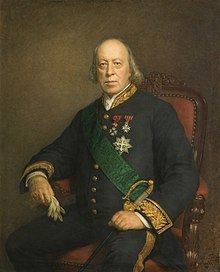Preceded by Camille de Tornaco Party Liberal Party Role Belgian Politician | Name Edmond Selys Political party Liberal Party Succeeded by Jules d\'Anethan | |
 | ||
Born 25 May 1813
Paris, France ( 1813-05-25 ) Died December 11, 1900, Liege, Belgium | ||
Baron Michel Edmond de Sélys Longchamps ([lɔ̃ʃɑ̃]; 25 May 1813 – 11 December 1900) was a Belgian liberal politician and scientist.
Contents

Sélys Longchamps was regarded as the world's greatest authority on dragonflies and damselflies. His wealth and influence enabled him to amass one of the finest collections of neuropteroid insects and to describe many species from around the world. His collection is housed in the Royal Belgian Institute of Natural Sciences.
He was the author of Monographie des Libellulidées d'Europe (1840) and Faune Belge (1842).
Sélys Longchamps was a wealthy aristocrat born in Paris. He was educated at home and never at university but became the leading student of Odonata (worldwide) and the Neuropteroid (worldwide) and Orthopteroid (mainly Europe) insects. He was also a leading ornithologist. A liberal representative in the Belgian Parliament he became Councillor for Waremme in 1846 entered the Belgian Senate in 1855 and was finally elected President of the Belgian Senate from 1880 to 1884. His early interest in birds is shown by a book of coloured figures of Belgian species painted when he was 16. Ornithology remained a lifelong interest and he assembled an ornithological museum at Waremme maintaining very large collections of birds, both European and Exotic and including a great auk and an egg. He was also interested in small mammals. At 18 (1831) he published his first scientific paper, a list of the insects of Liège and in 1837 a list of the dragonflies or Odonata and butterflies and moths or Lepidoptera - of Belgium. From that date on a continuous flow of papers on the Odonata appeared. The works were often monographic examples being, 1840 Monographie des Libellulides d'Europeand 1850 Revue des Odonates d'Europe, two large works on "Gomphines" and "Calopterygines". There were also synopses (works containing phylogenetic analyses, tables and keys) of the "Gomphines", Calopterygines", Agrionines", "Cordulines" and ( generic only )"Aeschnines". The only family not treated synoptically being the difficult "Libellulines". There are (very numerous) local faunas for dragonflies, appendices to travel works, phylogenetic and morphological notes. Sélys Longchamps met and began a collaboration with Hermann August Hagen in 1845; They jointly produced the Revue and two monographs. Hagen also aided work on the Synopses and sometimes Sélys is given as the author in Kirby's catalogue when Hagen is (in many such instances it is clearly stated by Sélys that he had never seen the insects and that Hagen was the author). Sélys is the properly attributed author of well over 1,000 species, an enormous number compared to Hagen and more than half of known species. Aware of being an "homme distrait" Sélys often affixed names to undescribed species in his collection (nomina nuda). This led to much later nomenclatural confusion. Sélys was an inveterate traveller spending long periods in most European countries and being an honorary member of almost all European entomological societies including the Royal Entomological Society which so honoured him in 1871. He helped to found the Société Entomologique de Belgique in 1856.
He amassed the greatest collection of Neuroptera and Orthoptera in the world incorporating the collections of Pierre André Latreille, Jules Pièrre Rambur, Jean Guillaume Audinet-Serville, and Félix Édouard Guérin-Méneville and wrote over 250 papers some of which are masterworks. His collection is in the Royal Belgian Institute of Natural Sciences although there are de Sélys types in many other museums, for instance the Hope Department of Entomology, University of Oxford. He died at Liège.
